Rain Removal
Rain removal is the process of removing rain or rain streaks from images to improve their visibility.
Papers and Code
Domain Generalization through Attenuation of Domain-Specific Information
Apr 09, 2025In this paper, we propose a new evaluation metric called Domain Independence (DI) and Attenuation of Domain-Specific Information (ADSI) which is specifically designed for domain-generalized semantic segmentation in automotive images. DI measures the presence of domain-specific information: a lower DI value indicates strong domain dependence, while a higher DI value suggests greater domain independence. This makes it roughly where domain-specific information exists and up to which frequency range it is present. As a result, it becomes possible to effectively suppress only the regions in the image that contain domain-specific information, enabling feature extraction independent of the domain. ADSI uses a Butterworth filter to remove the low-frequency components of images that contain inherent domain-specific information such as sensor characteristics and lighting conditions. However, since low-frequency components also contain important information such as color, we should not remove them completely. Thus, a scalar value (ranging from 0 to 1) is multiplied by the low-frequency components to retain essential information. This helps the model learn more domain-independent features. In experiments, GTA5 (synthetic dataset) was used as training images, and a real-world dataset was used for evaluation, and the proposed method outperformed conventional approaches. Similarly, in experiments that the Cityscapes (real-world dataset) was used for training and various environment datasets such as rain and nighttime were used for evaluation, the proposed method demonstrated its robustness under nighttime conditions.
SpikeDerain: Unveiling Clear Videos from Rainy Sequences Using Color Spike Streams
Mar 26, 2025Restoring clear frames from rainy videos presents a significant challenge due to the rapid motion of rain streaks. Traditional frame-based visual sensors, which capture scene content synchronously, struggle to capture the fast-moving details of rain accurately. In recent years, neuromorphic sensors have introduced a new paradigm for dynamic scene perception, offering microsecond temporal resolution and high dynamic range. However, existing multimodal methods that fuse event streams with RGB images face difficulties in handling the complex spatiotemporal interference of raindrops in real scenes, primarily due to hardware synchronization errors and computational redundancy. In this paper, we propose a Color Spike Stream Deraining Network (SpikeDerain), capable of reconstructing spike streams of dynamic scenes and accurately removing rain streaks. To address the challenges of data scarcity in real continuous rainfall scenes, we design a physically interpretable rain streak synthesis model that generates parameterized continuous rain patterns based on arbitrary background images. Experimental results demonstrate that the network, trained with this synthetic data, remains highly robust even under extreme rainfall conditions. These findings highlight the effectiveness and robustness of our method across varying rainfall levels and datasets, setting new standards for video deraining tasks. The code will be released soon.
Iterative Optimal Attention and Local Model for Single Image Rain Streak Removal
Mar 20, 2025High-fidelity imaging is crucial for the successful safety supervision and intelligent deployment of vision-based measurement systems (VBMS). It ensures high-quality imaging in VBMS, which is fundamental for reliable visual measurement and analysis. However, imaging quality can be significantly impaired by adverse weather conditions, particularly rain, leading to blurred images and reduced contrast. Such impairments increase the risk of inaccurate evaluations and misinterpretations in VBMS. To address these limitations, we propose an Expectation Maximization Reconstruction Transformer (EMResformer) for single image rain streak removal. The EMResformer retains the key self-attention values for feature aggregation, enhancing local features to produce superior image reconstruction. Specifically, we propose an Expectation Maximization Block seamlessly integrated into the single image rain streak removal network, enhancing its ability to eliminate superfluous information and restore a cleaner background image. Additionally, to further enhance local information for improved detail rendition, we introduce a Local Model Residual Block, which integrates two local model blocks along with a sequence of convolutions and activation functions. This integration synergistically facilitates the extraction of more pertinent features for enhanced single image rain streak removal. Extensive experiments validate that our proposed EMResformer surpasses current state-of-the-art single image rain streak removal methods on both synthetic and real-world datasets, achieving an improved balance between model complexity and single image deraining performance. Furthermore, we evaluate the effectiveness of our method in VBMS scenarios, demonstrating that high-quality imaging significantly improves the accuracy and reliability of VBMS tasks.
Feature Fusion Attention Network with CycleGAN for Image Dehazing, De-Snowing and De-Raining
Mar 08, 2025This paper presents a novel approach to image dehazing by combining Feature Fusion Attention (FFA) networks with CycleGAN architecture. Our method leverages both supervised and unsupervised learning techniques to effectively remove haze from images while preserving crucial image details. The proposed hybrid architecture demonstrates significant improvements in image quality metrics, achieving superior PSNR and SSIM scores compared to traditional dehazing methods. Through extensive experimentation on the RESIDE and DenseHaze CVPR 2019 dataset, we show that our approach effectively handles both synthetic and real-world hazy images. CycleGAN handles the unpaired nature of hazy and clean images effectively, enabling the model to learn mappings even without paired data.
Wavelet-Enhanced Desnowing: A Novel Single Image Restoration Approach for Traffic Surveillance under Adverse Weather Conditions
Mar 03, 2025Image restoration under adverse weather conditions refers to the process of removing degradation caused by weather particles while improving visual quality. Most existing deweathering methods rely on increasing the network scale and data volume to achieve better performance which requires more expensive computing power. Also, many methods lack generalization for specific applications. In the traffic surveillance screener, the main challenges are snow removal and veil effect elimination. In this paper, we propose a wavelet-enhanced snow removal method that use a Dual-Tree Complex Wavelet Transform feature enhancement module and a dynamic convolution acceleration module to address snow degradation in surveillance images. We also use a residual learning restoration module to remove veil effects caused by rain, snow, and fog. The proposed architecture extracts and analyzes information from snow-covered regions, significantly improving snow removal performance. And the residual learning restoration module removes veiling effects in images, enhancing clarity and detail. Experiments show that it performs better than some popular desnowing methods. Our approach also demonstrates effectiveness and accuracy when applied to real traffic surveillance images.
High-resolution Rainy Image Synthesis: Learning from Rendering
Feb 23, 2025Currently, there are few effective methods for synthesizing a mass of high-resolution rainy images in complex illumination conditions. However, these methods are essential for synthesizing large-scale high-quality paired rainy-clean image datasets, which can train deep learning-based single image rain removal models capable of generalizing to various illumination conditions. Therefore, we propose a practical two-stage learning-from-rendering pipeline for high-resolution rainy image synthesis. The pipeline combines the benefits of the realism of rendering-based methods and the high-efficiency of learning-based methods, providing the possibility of creating large-scale high-quality paired rainy-clean image datasets. In the rendering stage, we use a rendering-based method to create a High-resolution Rainy Image (HRI) dataset, which contains realistic high-resolution paired rainy-clean images of multiple scenes and various illumination conditions. In the learning stage, to learn illumination information from background images for high-resolution rainy image generation, we propose a High-resolution Rainy Image Generation Network (HRIGNet). HRIGNet is designed to introduce a guiding diffusion model in the Latent Diffusion Model, which provides additional guidance information for high-resolution image synthesis. In our experiments, HRIGNet is able to synthesize high-resolution rainy images up to 2048x1024 resolution. Rain removal experiments on real dataset validate that our method can help improve the robustness of deep derainers to real rainy images. To make our work reproducible, source codes and the dataset have been released at https://kb824999404.github.io/HRIG/.
End-to-end Inception-Unet based Generative Adversarial Networks for Snow and Rain Removals
Nov 07, 2024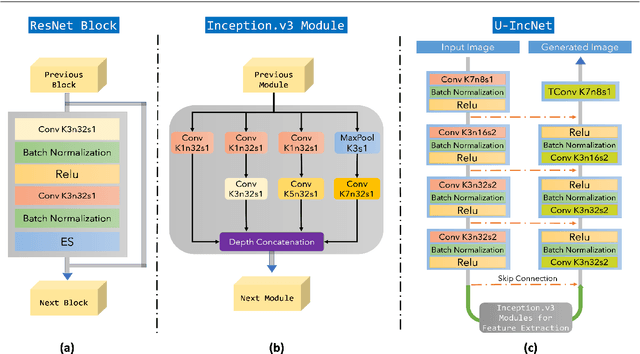

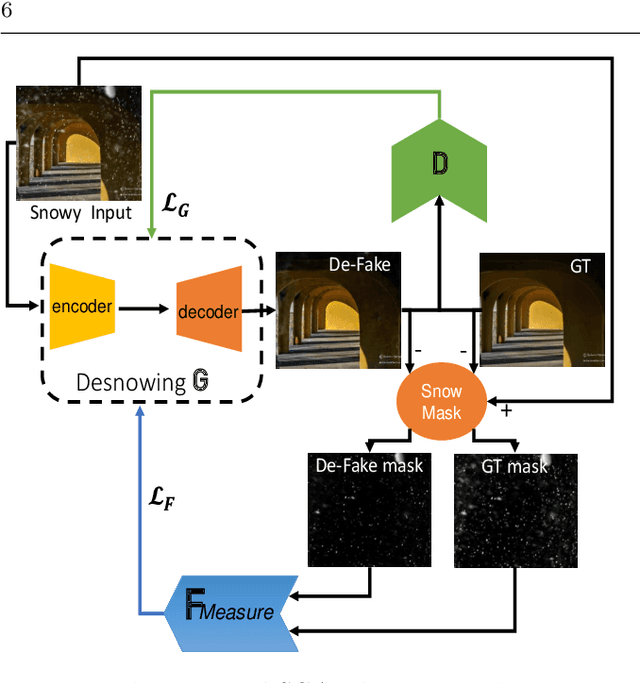

The superior performance introduced by deep learning approaches in removing atmospheric particles such as snow and rain from a single image; favors their usage over classical ones. However, deep learning-based approaches still suffer from challenges related to the particle appearance characteristics such as size, type, and transparency. Furthermore, due to the unique characteristics of rain and snow particles, single network based deep learning approaches struggle in handling both degradation scenarios simultaneously. In this paper, a global framework that consists of two Generative Adversarial Networks (GANs) is proposed where each handles the removal of each particle individually. The architectures of both desnowing and deraining GANs introduce the integration of a feature extraction phase with the classical U-net generator network which in turn enhances the removal performance in the presence of severe variations in size and appearance. Furthermore, a realistic dataset that contains pairs of snowy images next to their groundtruth images estimated using a low-rank approximation approach; is presented. The experiments show that the proposed desnowing and deraining approaches achieve significant improvements in comparison to the state-of-the-art approaches when tested on both synthetic and realistic datasets.
Gradient-Guided Parameter Mask for Multi-Scenario Image Restoration Under Adverse Weather
Nov 23, 2024Removing adverse weather conditions such as rain, raindrop, and snow from images is critical for various real-world applications, including autonomous driving, surveillance, and remote sensing. However, existing multi-task approaches typically rely on augmenting the model with additional parameters to handle multiple scenarios. While this enables the model to address diverse tasks, the introduction of extra parameters significantly complicates its practical deployment. In this paper, we propose a novel Gradient-Guided Parameter Mask for Multi-Scenario Image Restoration under adverse weather, designed to effectively handle image degradation under diverse weather conditions without additional parameters. Our method segments model parameters into common and specific components by evaluating the gradient variation intensity during training for each specific weather condition. This enables the model to precisely and adaptively learn relevant features for each weather scenario, improving both efficiency and effectiveness without compromising on performance. This method constructs specific masks based on gradient fluctuations to isolate parameters influenced by other tasks, ensuring that the model achieves strong performance across all scenarios without adding extra parameters. We demonstrate the state-of-the-art performance of our framework through extensive experiments on multiple benchmark datasets. Specifically, our method achieves PSNR scores of 29.22 on the Raindrop dataset, 30.76 on the Rain dataset, and 29.56 on the Snow100K dataset. Code is available at: \href{https://github.com/AierLab/MultiTask}{https://github.com/AierLab/MultiTask}.
Low-rank Adaptation-based All-Weather Removal for Autonomous Navigation
Nov 26, 2024All-weather image restoration (AWIR) is crucial for reliable autonomous navigation under adverse weather conditions. AWIR models are trained to address a specific set of weather conditions such as fog, rain, and snow. But this causes them to often struggle with out-of-distribution (OoD) samples or unseen degradations which limits their effectiveness for real-world autonomous navigation. To overcome this issue, existing models must either be retrained or fine-tuned, both of which are inefficient and impractical, with retraining needing access to large datasets, and fine-tuning involving many parameters. In this paper, we propose using Low-Rank Adaptation (LoRA) to efficiently adapt a pre-trained all-weather model to novel weather restoration tasks. Furthermore, we observe that LoRA lowers the performance of the adapted model on the pre-trained restoration tasks. To address this issue, we introduce a LoRA-based fine-tuning method called LoRA-Align (LoRA-A) which seeks to align the singular vectors of the fine-tuned and pre-trained weight matrices using Singular Value Decomposition (SVD). This alignment helps preserve the model's knowledge of its original tasks while adapting it to unseen tasks. We show that images restored with LoRA and LoRA-A can be effectively used for computer vision tasks in autonomous navigation, such as semantic segmentation and depth estimation.
Learning Truncated Causal History Model for Video Restoration
Oct 15, 2024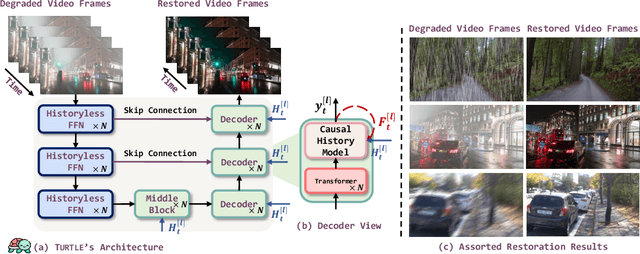
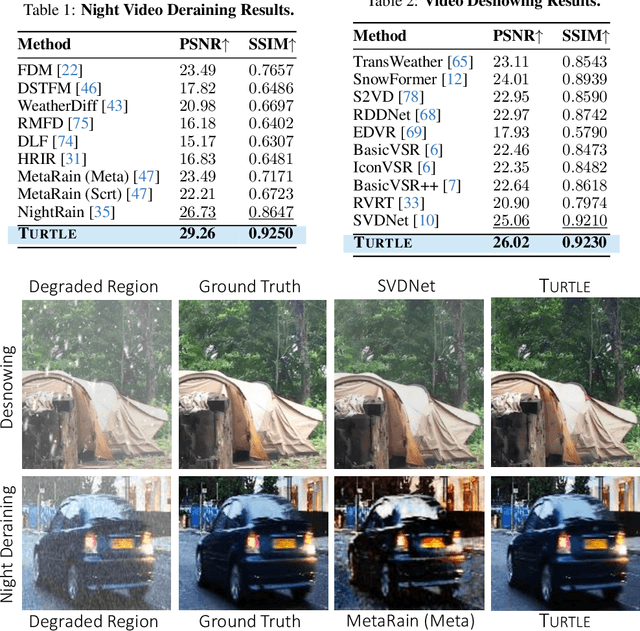

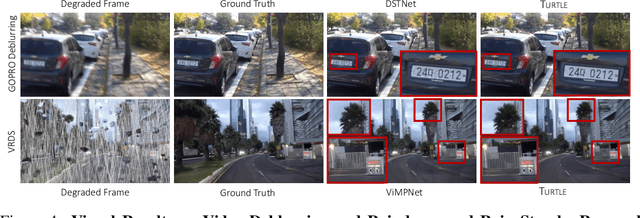
One key challenge to video restoration is to model the transition dynamics of video frames governed by motion. In this work, we propose TURTLE to learn the truncated causal history model for efficient and high-performing video restoration. Unlike traditional methods that process a range of contextual frames in parallel, TURTLE enhances efficiency by storing and summarizing a truncated history of the input frame latent representation into an evolving historical state. This is achieved through a sophisticated similarity-based retrieval mechanism that implicitly accounts for inter-frame motion and alignment. The causal design in TURTLE enables recurrence in inference through state-memorized historical features while allowing parallel training by sampling truncated video clips. We report new state-of-the-art results on a multitude of video restoration benchmark tasks, including video desnowing, nighttime video deraining, video raindrops and rain streak removal, video super-resolution, real-world and synthetic video deblurring, and blind video denoising while reducing the computational cost compared to existing best contextual methods on all these tasks.
 Add to Chrome
Add to Chrome Add to Firefox
Add to Firefox Add to Edge
Add to Edge